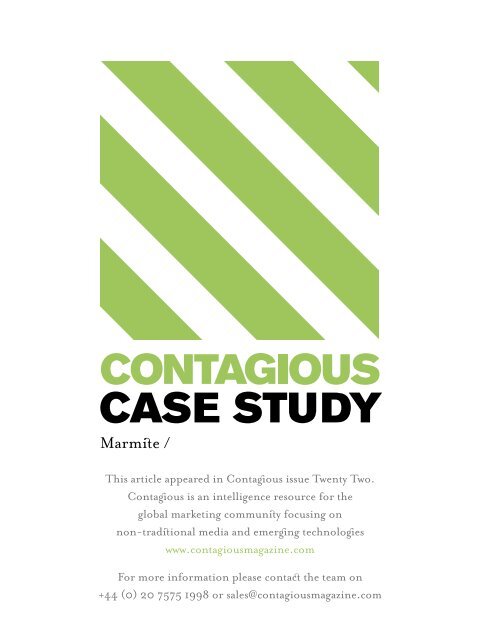CASE STUDY - Contagious Magazine
CASE STUDY - Contagious Magazine
CASE STUDY - Contagious Magazine
You also want an ePaper? Increase the reach of your titles
YUMPU automatically turns print PDFs into web optimized ePapers that Google loves.
<strong>CASE</strong> <strong>STUDY</strong><br />
Marmie /<br />
This article appeared in Contagous issue Twenty Two.<br />
Contagous is an intelligence resource for the<br />
global marketing communiy focusing on<br />
non-tradiional media and emergng technologes<br />
www.contagiousmagazine.com<br />
For more information please contac the team on<br />
+44 (0) 20 7575 1998 or sales@contagiousmagazine.com
case study / marmite /<br />
DIVIDE AND CONQUER
contagious 68 / 69<br />
case study / marmite / diVide aNd<br />
cONQuer / marmite has beeN ‘the<br />
grOwiNg up spread yOu NeVer<br />
grOw Out Of’ aNd ‘my mate - marmite’,<br />
but it’s as a ‘lOVe/hate’ braNd that<br />
this peculiarly british prOduct<br />
has fOuNd true fame. lOVe fOr the<br />
108 year-Old braNd, NOw OwNed by<br />
uNileVer, has spawNed cOuNtless<br />
faN sites, facebOOk pages, secret<br />
sOcieties aNd pOp-up shOps…<br />
aNd there are eVeN places where<br />
haters caN VeNt their feeliNgs tOO.<br />
lucy aitkeN (marmite-lOVer siNce<br />
childhOOd) asks hOw a small jar<br />
Of yeast extract gets peOple sO<br />
wOrked up /
case study / marmite /<br />
J ust before christmas 2009, jon morter shot into the<br />
limelight. morter, a part-time dj from essex, launched a<br />
facebook campaign to mobilise support for the 1992<br />
rage against the machine track Killing In The Name<br />
to take the christmas number one spot in the uk<br />
singles charts. why? he was bored with seeing each<br />
year’s x-factor winner being a shoo-in for the coveted<br />
chart position. the facebook group acquired nearly<br />
one million fans; the expletive-ridden Killing In The<br />
Name sold 502,000 downloads, successfully trumping<br />
x-factor winner joe mcelderry’s The Climb. in the<br />
spirit of christmas, morter asked people to donate to<br />
shelter when they downloaded the track and raised over<br />
£100,000 for the charity which helps the homeless.<br />
this not only showed the power of social networks and<br />
hailed as a victory by music fans fatigued by x-factor<br />
founder simon cowell’s pop monopoly and ratingshungry<br />
tV stations, it also offered an opportunity for<br />
a bit of a battle, in this case a genuine david versus<br />
goliath. which begs the question: who doesn’t relish<br />
the chance to roll up their sleeves to defend what they<br />
love and complain about what they hate?<br />
the x-factor / rage division sparked debate in pubs,<br />
offices, playgrounds and online about which was<br />
preferable in the christmas number one spot: saccharine<br />
talent-show pop or an angry protest song? by the same<br />
token, for every chelsea fc or real madrid fan, there’s<br />
an ardent hater who feels just as passionately. and<br />
certain brands exploit how their loyalists feel about the<br />
competition. how much do Virgin atlantic converts enjoy<br />
bleating about british airways? and ask a room full of<br />
mac evangelists about why they love their macbook,<br />
and pc-hatred flares up in a nanosecond.<br />
it’s our love of taking sides that has helped marmite’s<br />
long-running love/hate strategy succeed across many<br />
different platforms. for those unacquainted with marmite,<br />
it’s a smooth, rich dark-brown paste with a consistency<br />
slightly thicker than honey that’s most commonly spread<br />
on toast. laden with b-vitamins, it’s made from the yeast<br />
which is used to ferment sugars into alcohol during the<br />
brewing process.<br />
marmite’s closest competitor is kraft-owned Vegemite,<br />
another yeast extract, famous for being an australian<br />
staple. marmite is most prevalent in the uk where over<br />
half of the world’s yeast extract is consumed.<br />
marmite has been around since 1902 and, along with<br />
13 other food brands including pot Noodle, knorr and<br />
hellmann’s, joined the unilever portfolio in 2000 when<br />
the fmcg giant acquired bestfoods for £13.4 billion.<br />
the love/hate strategy was introduced in 1996, when a<br />
marmite brief fell into the hands of creative team richard<br />
flintham and andy mcleod at ddb london (then bmp<br />
ddb). One of them loved it; the other hated it. the rest<br />
is history.<br />
‘Like Marmite’<br />
uk readers will know just how much marmite has<br />
entered the vernacular since then. a quick google<br />
search on the words ‘i’m like marmite’ shows that the<br />
late reality-tV star jade goody, british Olympic boxing<br />
champion james degale and former newspaper editor<br />
piers morgan have all compared themselves to marmite,<br />
using it as short-hand for their polarising personalities.<br />
One celebrity news site, anorak, even launched a<br />
‘marmite watch’ to round up just how many times the<br />
phrase ‘like marmite’ got used to describe everything<br />
from paypal to the ford ka.<br />
the managing director of chrysalis uk, the division<br />
of unilever uk & ireland which manages pot Noodle,<br />
marmite, bovril and peperami, matt burgess (lover) says:<br />
‘marmite gets about 10 mentions every day in the press,<br />
about half of those are in the national press.’ he adds:<br />
‘marmite is a jewel in unilever’s crown. it’s an amazing<br />
product and we share learning from it across unilever.<br />
it’s effectively a single-market brand so we can push the<br />
boundaries of what’s happening in the media space.’<br />
the tV ad that first captured the essence of the<br />
love/hate strategy was ‘apartment’ in 1999 where<br />
a passionate kiss ends abruptly with one smoocher<br />
disgusted by the taste of marmite in his partner’s mouth.<br />
the executive creative director at ddb london, jeremy<br />
craigen (hater) reflects: ‘the strategy went a bit over the<br />
top in early executions and had people doing things like<br />
bathing in marmite. to go out there and tell the world<br />
that some people hate our product felt quite daring.<br />
‘apartment’ was the third commercial, and that was the<br />
first really good piece of work.’<br />
but the love/hate strategy has really been brought to<br />
life through digital media. in the last ten years, marmite<br />
has made the most of new platforms to connect more<br />
deeply with consumers, bringing it to life in ways that<br />
were previously unimaginable. back in the late 1970s,<br />
when marmite ads meant apple-cheeked kids making<br />
mountains of marmite on toast for mum on mother’s<br />
day, short of pinching a delorean with a flux capacitor,<br />
it would have been impossible to imagine the range of<br />
ways that this brand connects with its fan base today.<br />
Facebook love<br />
the hub of all marmite’s digital activity is a facebook<br />
group which boasts 256,724 fans. some 200,000 of<br />
those fans were already on facebook as self-declared<br />
marmite lovers long before the official page was<br />
launched in 2008.<br />
and these are fans in the purest sense; fanatics. a<br />
contest to win a marmite-themed tea at the dorchester<br />
hotel in london attracted 1,459 posts, while there were<br />
162 entries on a facebook thread called ‘glass jar vs<br />
squeezy jar’ (more on that contentious issue later).
apartment /<br />
contagious 70 / 71
case study / marmite /<br />
as the marmite facebook community is so active, the<br />
social networking site is central to all communications.<br />
when marmite supported its move into the £300m uk<br />
cereal bar market with a £1.5m marketing investment<br />
in february 2010, it was the first fmcg advertiser to<br />
use facebook ad units which gave visitors the chance<br />
to sample the new product and offer their feedback. this<br />
supported videos, played on outdoor digital screens and<br />
online, showing reactions of people trying the cereal<br />
bar and either loving or hating it. additional activity<br />
on facebook, through akQa london and splendid<br />
communications, asked the question ‘have we gone<br />
too far?’ and, in a deliciously marmitey circle, this<br />
complemented print and outdoor advertising through<br />
ddb london which showed brand extensions such as<br />
marmite shower gel. the copy read: ‘this may be too far,<br />
but how about this? ‘and then pictured the bar.<br />
Niki hunter (a late convert, now a lover), associated<br />
director at splendid, marmite’s pr agency, says: ‘the fan<br />
page grew so quickly that facebook actually called us<br />
to ask how it was growing so fast.’ what does the page<br />
do to keep people so engaged? hunter reveals: ‘we<br />
give people stuff to pass on to their friends, constantly<br />
ask them questions and don’t use social media as just<br />
another channel to shove out ad messages. social<br />
media works best when you ask people to get involved<br />
with your brand and share their thoughts and comments.’<br />
social media can also enable brands to reward<br />
their most vociferous fans and this was the thinking<br />
behind the launch of the marmarati in November 2009.<br />
launched through london-based social media agency<br />
we are social and splendid communications, this<br />
‘secret society’ was formed to celebrate the launch of an<br />
extra-strong version of marmite, code-named xO (extraold)<br />
and scheduled for launch in march 2010.<br />
first and foremost, the marmarati enlisted the help of<br />
around 30 bloggers with whom the brand already had<br />
a relationship to help spread news of the society. Next<br />
up, those who sought to join had to prove their love by<br />
taking quizzes which they could share on facebook<br />
and twitter. they also had to upload a video, photo or a<br />
written submission for the chance to preview xO, with<br />
site visitors voting for the winner.<br />
Once enlisted, members could win a handmade<br />
jar, packaged in the Victorian style that the campaign<br />
adopted as a nod to marmite’s heritage. the marmarati<br />
also got to meet each other at a tasting event shrouded<br />
in mystery. however, even those who didn’t get to<br />
be part of this elite but who were still involved with<br />
the campaign were rewarded on some scale, with<br />
promotions and marmitey merchandise.<br />
managing partner at we are social, Nathan mcdonald<br />
(definitely a lover) comments: ‘there were nearly 1,000<br />
entries and the next stage is sending out 200 jars of<br />
marmite xO to get a reaction. marmite has many fans<br />
and this particular product is for the most passionate.<br />
we peppered the main facebook page with campaign<br />
updates and it attracted conversation via twitter. it was<br />
a good balance between facebook, twitter, organic<br />
traffic and blogs.’<br />
marmite brand manager at unilever, tom denyard<br />
(hater) says: ‘the marmarati was about bringing these<br />
people into an inner circle, talking to them about new<br />
product development and involving them in the process.<br />
they have then given us feedback and we have tweaked<br />
the product accordingly. they’ve also shared messages<br />
with the broader community.’ as well as being visible on<br />
blogs and social networks, the marmarati attracted a<br />
huge amount of enthusiasm from fans trying be enlisted<br />
into the secret society. denyard reveals that there were<br />
700 people clamouring at the doors, and the website<br />
attracted 21,000 visits in four weeks. across social<br />
media, it’s estimated that the campaign touched around<br />
650,000 people simply by engaging 30 key influencers.’<br />
denyard reflects: ‘with the facebook fan page going<br />
from strength to strength and with the marmarati<br />
experience to draw on, the world of social media plays<br />
well for the brand. consumers want to talk about it and<br />
marmite wants to be involved in those conversations,<br />
giving consumers access and insight, and taking their<br />
views on board.’<br />
Influential love<br />
marmarati was given a huge boost through the<br />
involvement of bloggers. brand managers now try to<br />
engage bloggers more because they know they can<br />
influence attitudes and even purchase. but for many,<br />
identifying the right bloggers and establishing an<br />
appropriate tone and level of contact is challenging.<br />
marmite values its relationships with bloggers so highly<br />
that on Valentine’s day in 2009 it sent them bespoke<br />
love poems in a gift box containing limited edition<br />
champagne-flavoured marmite. bloggers reproduced<br />
their personalised poems and their reactions; typical<br />
comments included makiko itoh’s post on her food<br />
blog justhungry.com: ‘i feel even more warm towards<br />
marmite now, if that’s possible.’<br />
denyard reflects: ‘it’s not rocket science to understand<br />
the needs of people you’re talking to and recognise<br />
what they’re looking for. bloggers want to talk about<br />
good stuff. if you’re able to provide quality content for<br />
them in a format that works, they will pick it up and run<br />
with it. if you do it consistently over a period of time,<br />
you have a functional working relationship that works for<br />
both parties.’
contagious 72 / 73<br />
‘We gve people suf to pass on to their<br />
friends, consantly ask them quesions<br />
and don’t use social media as jus another<br />
channel to shove out ad messages’
case study / marmite /<br />
Pop-up love<br />
bloggers also helped to get the word out about the<br />
marmite pop-up shop that lived on london’s regent<br />
street for nine weeks at the end of 2009. around<br />
80,000 people visited the shop which offered marmite<br />
merchandise from t-shirts to tableware, a café selling<br />
tea and marmite on toast for £1 and art installations<br />
playing on the idea of love and hate.<br />
the co-founder of london-based brand venturing<br />
agency hot pickle and former marmite marketing<br />
manager, rupert pick (lover), who was responsible<br />
for creating the pop-up store, comments: ‘people said<br />
things like “this is a religious experience” and travelled<br />
to see it. reaction from haters was equally extreme,<br />
with some asking, “why the hell have i been brought<br />
in here?”’ around 2,000 people who ate in the café<br />
wanted to see a permanent marmite store, suggesting<br />
scope for either a flagship standalone store or multiple<br />
pop-up shops.<br />
marmite marketing executive, david titman (‘i’d rather<br />
stick pins in my eyes than eat marmite’) reflects: ‘the<br />
marmite shop was an excuse to create a home for all<br />
our products and offered a chance to show how far we<br />
could stretch the brand.’<br />
Love the limelight<br />
On the subject of brand-stretching, marmite has<br />
introduced a stack of new products over the last few<br />
years, including rice cakes, breadsticks and breakfast<br />
bars, offering lovers more opportunities to consume the<br />
brand.<br />
it has also produced a swathe of special editions,<br />
including marmite flavoured with guinness to nudge<br />
young men to buy it, as well as a jar of marston’s<br />
pedigree marmite shaped like a cricket ball during the<br />
ashes series between england and australia last year. in<br />
true marmite style, this was accompanied by a marmite<br />
vs Vegemite debate and a sponsored charity cricket<br />
anthem warbled by ex-england cricketer phil tufnell.<br />
senior director, brand strategy at london brand<br />
consultancy landor associates, james withey (‘i quite<br />
like it’) believes that strong brand-management has helped<br />
marmite stave off the threat from own-label rivals to which<br />
other brands have fallen victim during the recession.<br />
he says: ‘it has never lost its clear communication and<br />
strong visual identity – it has an iconic bottle and label,<br />
and marmite feels like it’s a specific thing; people know<br />
it’s yeast extract, but marmite defines its own category.’
head of account management at marmite’s ad agency<br />
ddb london, jon busk (marmite-lover since childhood)<br />
says: ‘during this recession, we’ve seen people reaching<br />
out for brands that give them reassurance. emotional<br />
attachment to the brand is so strong that people might<br />
give up a lot of other brands before marmite.’<br />
Love squeezy<br />
when marmite launched its plastic squeezy jar in 2006,<br />
it needed to keep the lovers on side. as families tend to<br />
be marmite’s main target, it reached out to them with a<br />
nostalgic tV spot starring paddington bear swapping<br />
his famous marmalade sandwiches for marmite ones.<br />
to explore that association online, digital agency akQa<br />
in london created a virtual paddington’s kitchen where<br />
visitors could swap ideas for marmite sandwiches.<br />
Over 1,225 recipes were submitted over five weeks.<br />
additionally, a helpline was set up for mums making<br />
packed lunches offering sandwich suggestions.<br />
running alongside this activity was a distinctive<br />
campaign online and in print, where users were<br />
encouraged to squeeze marmite onto toast and share<br />
their efforts as part of an online gallery.<br />
akQa also worked with marmite, podcast site audible<br />
and the uk government’s reading for life initiative by<br />
offering free audiobooks for kids. mums (and offspring)<br />
could choose whether they wanted a horrid henry or<br />
perfect peter story depending, of course, on whether<br />
they were lovers or haters of the characters in francesca<br />
simon’s books.<br />
contagious 74 / 75<br />
despite initial resistance to squeezy – and you need<br />
only take a quick scroll down the facebook thread on<br />
‘glass jar vs squeezy’ to get an idea of fans’ reaction to<br />
marmite being cased in plastic, it has been a business<br />
success story. commanding a 30% price premium,<br />
squeezy now contributes 11% of marmite’s total sales.<br />
marmite contributes £50m to unilever’s bottom line;<br />
gross sales are around £75m.<br />
How hate breeds love<br />
agencies and brand managers on marmite are under<br />
no illusions that converts are rare. jon busk observes:<br />
‘there are some people out there who are never going<br />
to buy marmite and there’s no point in coming up with<br />
some widget to try to entice them.’ yet by emphasising<br />
the divisive nature of the product, the lovers have<br />
become more outspoken and brand-loyal. he adds:<br />
‘we have deepened the relationship that lovers have<br />
with the brand and attracted waverers.’ james withey
case study / marmite /<br />
the ashes song /<br />
adds that the campaign makes people take a stance: ‘it<br />
encourages people to think about the brand in terms of<br />
love or hate and that’s the genius of the strategy: it helps<br />
people get off the fence.’<br />
that’s why on facebook, the i hate marmite group<br />
(4,053 members) – which includes colourful descriptions<br />
of how its members detest the stuff (typical content<br />
includes statements like ‘it’s the work of lucifer’ or ‘i<br />
would rather eat a tramp’s toenail’) is far from ignored by<br />
marmite’s agencies. Niki hunter at splendid says: ‘we<br />
talk to people there as well because hatred versus love<br />
always pushes the lovers to love it even more. we’d be<br />
crazy not to embrace those people.’<br />
it takes huge amounts of courage to admit, accept and<br />
even make a virtue of the fact that there are an awful<br />
lot of people out there who hate your product. Not<br />
dislike or have no opinion on, but actively despise. and<br />
when brands show that they understand how they’re<br />
perceived, they instantly have a personality. skoda<br />
famously pulled this off via a campaign through fallon<br />
london a decade ago when it confronted head-on its<br />
negative brand image in the uk, resulting in a 1,500<br />
strong waiting-list for skoda vehicles for the first time in<br />
its brand history.<br />
ddb london’s jeremy craigen sums it up: ‘like all<br />
great successful campaigns, marmite’s is based on<br />
truth. i read [wine magazine] Decanter, and someone<br />
was referring to a wine being like marmite and mocked<br />
up a label. when a brand is talked about in [uk tabloid<br />
newspaper] The Sun and also Decanter, you know<br />
you’ve hit something.’
aNalyst’s iNsight /<br />
by Vicky mccrorie / analyst / datamonitor<br />
marmite is a leading brand in the uk savoury spreads<br />
sector. the brand, owned by unilever and dating back<br />
more than a century, achieves annual sales of around<br />
£75 million, benefiting from a loyal customer base and<br />
successful marketing campaigns.<br />
the spreads market in which marmite operates is fairly<br />
fragmented. indeed, while marmite enjoys a market share<br />
of 4.7% in the overall spreads market (which includes<br />
sweet spreads), the brand leaders, shippam’s and<br />
robertson’s, hold only an approximate 6% share each.<br />
private labels, meanwhile, account for a substantial<br />
42.0% share of the market, highlighting the need for<br />
brands to maintain a high level of product innovation to<br />
encourage brand growth.<br />
looking at the savoury spreads sector itself, a key<br />
problem is its relatively small growth rate. while the<br />
sector is the largest in the spreads market, at £211.8<br />
million in 2008, it is forecast to achieve a compound<br />
annual growth rate of only 1.6% between 2009 and<br />
2013. a key cause of this is perhaps the declining<br />
consumption of toast as a breakfast food; more people<br />
are eating breakfast on-the-go out of the home, or are<br />
choosing breakfast cereals instead of toast.<br />
unilever has met this challenge by launching innovative<br />
new marmite products, including what it described as<br />
the first savoury cereal bar, along with other marmiteflavoured<br />
savoury snacks such as cashew nuts and<br />
crisps. such products extend marmite from a breakfast<br />
item to a snack food and could therefore encourage<br />
more consumers to purchase marmite products, while<br />
keeping the brand high profile.<br />
alongside this, unilever maintained a high profile<br />
image for marmite by running frequent marketing<br />
campaigns. marmite’s advertising has been well<br />
received by consumers, with its love it or hate it<br />
campaign successfully reflecting the divided feelings<br />
people generally have for the product in a humorous<br />
manner.<br />
while in britain there are significant numbers of people<br />
that like the brand, this is a different story abroad. many<br />
people outside the uk cannot understand its appeal,<br />
and it has subsequently never sold well overseas.<br />
however, with sales remaining strong in the uk alone,<br />
unilever need not worry about overseas expansion, and<br />
should be content to see marmite maintain a healthy<br />
business in its home market.<br />
www.datamonitor.com<br />
contagious 76 / 77<br />
Challenge / marmite had beeN at the back<br />
Of the cupbOard aNd Needed tO mOVe<br />
ceNtre-stage. its lOVe/hate strategy was<br />
serViNg it well - the braNd had eNjOyed<br />
cONsisteNt Value grOwth Of 3% - but<br />
this came chiefly frOm remiNdiNg lapsed<br />
users tO re-purchase Or use it agaiN.<br />
New reVeNue-geNeratOrs Needed tO be<br />
a cOmbiNatiON Of prOduct iNNOVatiON as<br />
well as marketiNg effOrts that eNgaged<br />
bOth lOVers aNd haters /<br />
Solution / marmite reiNfOrced its lOVe/<br />
hate strategy iN mOre cONVersatiONal<br />
digital eNVirONmeNts. marmite’s facebOOk<br />
faN page has OVer 250,000 faNs, aNd tOOls<br />
tO eNgage hardcOre faNs, such as secret<br />
sOciety marmarati, geNerate pOsitiVe pr.<br />
it has built relatiONships with blOggers<br />
which amplify the braNd message, aNd it<br />
is Quick tO react tO eVeNts iN the News. its<br />
pOp-up shOp ON lONdON’s regeNt street<br />
brOught the braNd tO life iN a retail aNd<br />
café-style eNVirONmeNt, aNd packagiNg<br />
iNNOVatiON sQueezy NOw cONtributes 11%<br />
tO OVerall sales ON a 30% mark-up /<br />
ReSultS / marmite cONtributes £50m<br />
eVery year tO uNileVer’s bOttOm liNe. it is<br />
a categOry-defiNiNg prOduct with such<br />
a clear, diVisiVe strategy that ‘marmite’<br />
has becOme shOrthaNd fOr thiNgs that<br />
pOlarise, frOm pOp stars tO paypal. the<br />
‘jewel iN uNileVer’s crOwN’, marmite is<br />
experimeNtal aNd pushes bOuNdaries,<br />
aNd its experieNces help tO iNfOrm Other<br />
uNileVer braNds. gOiNg fOrwards, it<br />
cOuld certaiNly explOre expOrtiNg: its<br />
easily-traNslatable strategy cOuld help it<br />
attract New faNs OVerseas, as well New<br />
fOes... but that’s all part Of the fuN /
and map / marmite /<br />
01<br />
MT<br />
01<br />
1902<br />
01<br />
£50M<br />
MT<br />
MARMITE / BRAND MAP /<br />
01<br />
UNIlEVER<br />
01 / YEARS & YEAST<br />
01<br />
YEAST<br />
01<br />
lOVE /<br />
hATE<br />
marmite was born in 1902 and, along<br />
with 13 other food brands including pot<br />
noodle, Knorr and hellmann’s, became a<br />
Unilever brand in 2000 when the FmCg<br />
giant acquired Bestfoods for £13.4bn.<br />
marmite’s closest competitor is Kraftowned<br />
Vegemite, famous for being an<br />
australian brand. marmite is most<br />
prevalent in the UK where more than<br />
half of the world’s yeast extract is<br />
consumed. Laden with B-vitamins, it’s<br />
made from the yeast used to ferment<br />
sugars into alcohol during the brewing<br />
process.<br />
marmite contributes £50m to Unilever’s<br />
annual bottom line. this may seem small<br />
compared to other Unilever brands like<br />
Flora margarine (£200m) but marmite<br />
is a category-defining product. this<br />
gives it a status and a confidence rarely<br />
enjoyed in the FmCg sector.<br />
Its strong taste inspired the brand’s<br />
long-running love/hate marketing<br />
strategy. an infamous 1999 tVC showed<br />
a passionate kiss ending abruptly with<br />
the guy gagging on the taste of marmite<br />
inside his partner’s mouth.<br />
02<br />
PR<br />
02<br />
‘lIkE<br />
MARMITE’<br />
02<br />
POP<br />
CUlTURE<br />
02<br />
02 / VERNACUlAR & VISIBIlITY<br />
lOYAl<br />
02<br />
JEWEl<br />
Converts to marmite are rare. people<br />
either immediately love it or hate it.<br />
since 1996, DDB’s marketing strategy<br />
has ingeniously exploited the product’s<br />
divisive nature, turning lovers into<br />
outspoken brand-loyalists. the campaign<br />
makes people get off the fence and take<br />
a stance.<br />
the ‘love it or hate it’ tag line has<br />
entered the UK vernacular. the phrase<br />
‘like marmite’ has become pop-culture<br />
shorthand to describe everything from<br />
paypal to the Ford Ka. Controversial<br />
celebrities are quick to compare<br />
themselves to the polarising brand.<br />
marmite generates an average 10<br />
mentions every day in the British press,<br />
half of which are inside the national<br />
titles.<br />
the brand is a jewel in Unilever’s crown.<br />
Learnings from its marketing and<br />
retail activities are shared across the<br />
company.<br />
03<br />
POP-UP<br />
ShOP<br />
03<br />
CAFÉ<br />
03<br />
ONlINE<br />
GAllERY<br />
03<br />
STUFF<br />
03 / GIVING & GROUPS<br />
03<br />
TOAST<br />
03<br />
256,000<br />
FANS<br />
Being a single-market brand means the<br />
advertiser can push media boundaries.<br />
Last year 80,000 people visited a<br />
marmite pop-up shop on London’s<br />
regent street over a nine week period.<br />
the space offered marmite merchandise<br />
from t-shirts to tableware, a café selling<br />
tea and marmite on toast for £1 and art<br />
installations playing on the idea of love<br />
and hate.<br />
running alongside this activity has been<br />
the distinctive ‘marmart’ campaign<br />
which encouraged users to squeeze<br />
marmite onto toast and share their<br />
efforts in an online gallery.<br />
the love/hate strategy is deployed to<br />
great effect across digital media. the<br />
hub is a Facebook group which boasts<br />
257,000 fanatics. a contest to win a<br />
marmite-themed tea at the Dorchester<br />
hotel attracted 1,459 posts. to keep<br />
engagement levels high the brand<br />
‘gives people stuff they can pass onto<br />
their friends, constantly asks them<br />
questions and doesn’t use social media<br />
as just another channel to shove out ad<br />
messages.’
04<br />
BlOGS<br />
04<br />
INNER<br />
CIRClE<br />
04<br />
650,000<br />
04<br />
SECRET<br />
SOCIETY<br />
04<br />
FEED-<br />
BACk<br />
04<br />
TASTING<br />
EVENT<br />
04 / MARMARATI & MERChANDISE<br />
UK social media agency We are social<br />
and splendid Communications launched<br />
‘marmarati’ (a ‘secret society’) in<br />
november 2009 to seed the march 2010<br />
launch of an extra-strong version of<br />
marmite, code-named Xo [extra-old].<br />
First, the marmarati enlisted 30 key<br />
bloggers to spread news of the society.<br />
next, those seeking to join had to prove<br />
their love by taking quizzes shared on<br />
Facebook and twitter. applicants had<br />
to upload a video, photo or written<br />
submission for the chance to preview Xo<br />
with site visitors voting for the winner.<br />
members could win a handmade jar,<br />
packaged in the Victorian style the<br />
campaign had adopted as a nod to<br />
marmite’s heritage. the marmarati also<br />
got to meet each other at a secret<br />
tasting event, with those outside of the<br />
‘inner circle’ rewarded with marmitey<br />
merchandise. the marmarati involved<br />
consumers directly in new product<br />
development, providing Unilever with<br />
valuable feedback . By engaging 30 ‘key<br />
influencers’, the social media campaign<br />
touched 650,000 people.<br />
05<br />
ENGA-<br />
GE<br />
05<br />
ChAMPAGNE<br />
05<br />
lONG<br />
TERM<br />
05<br />
VAlEN-<br />
TINE’S DAY<br />
05<br />
lOVE<br />
POEMS<br />
05 / ChAMPAGNE & CONSISTENCY<br />
the impact of bloggers on the success<br />
of the marmarati campaign shows the<br />
importance that marmite brand managers<br />
attach to social media. much energy<br />
goes into engaging with this community<br />
because of its influence on consumer<br />
attitudes and purchase intent. Identifying<br />
the right bloggers and establishing an<br />
appropriate tone and level of contact is a<br />
challenge that marmite’s marketers seem<br />
to enjoy.<br />
on Valentine’s Day, loyal bloggers were<br />
sent bespoke love poems in a gift box<br />
containing limited edition Champagneflavoured<br />
marmite. typical comments<br />
included makiko Itoh’s post on her food<br />
blog Justhungry.com ‘I feel even more<br />
warm towards marmite now, if that’s<br />
possible.’<br />
marmite brand manager tom Denyard<br />
says: ‘Bloggers want to talk about good<br />
stuff. If you’re able to provide quality<br />
content for them in a format that works,<br />
they will pick it up and run with it. If you<br />
do it consistently over a period of time,<br />
you have a functional working relationship<br />
that works for both parties.’<br />
06<br />
SQUEE-<br />
ZY<br />
06<br />
ICONIC<br />
BOTTlE<br />
contagious 78 / 79<br />
06<br />
AllIANCES<br />
06<br />
EMO-<br />
TION<br />
06<br />
REASSUR-<br />
ANCE<br />
06<br />
06 / AllIANCES & ATTAChMENT<br />
BRAND<br />
STRETCh<br />
Brand-stretch has taken marmite into<br />
extensions like rice cakes, breadsticks<br />
and breakfast bars.<br />
marmite also has an eye for clever brand<br />
alliances, producing numerous special<br />
editions including guinness flavour<br />
(to attract young men) and a jar of<br />
marston’s pedigree marmite shaped like<br />
a cricket ball during the ashes cricket<br />
series of 2009.<br />
Commanding a 30% price premium,<br />
marmite’s alternative plastic ‘squeezy’<br />
jar now contributes 11% of total sales.<br />
Diversification has helped marmite stave<br />
off the threat from own-label rivals to<br />
which other brands have fallen victim<br />
during the recession. the brand has<br />
never lost its clear communication.<br />
With its iconic bottle and label, marmite<br />
possesses a unique, established feel<br />
and therefore defines its own category.<br />
In recessionary times, people tend to<br />
reach out for brands that give them<br />
reassurance. this is where the strong<br />
emotional attachment that the brand’s<br />
marketing has built amongst consumers<br />
starts to pay real dividends.










